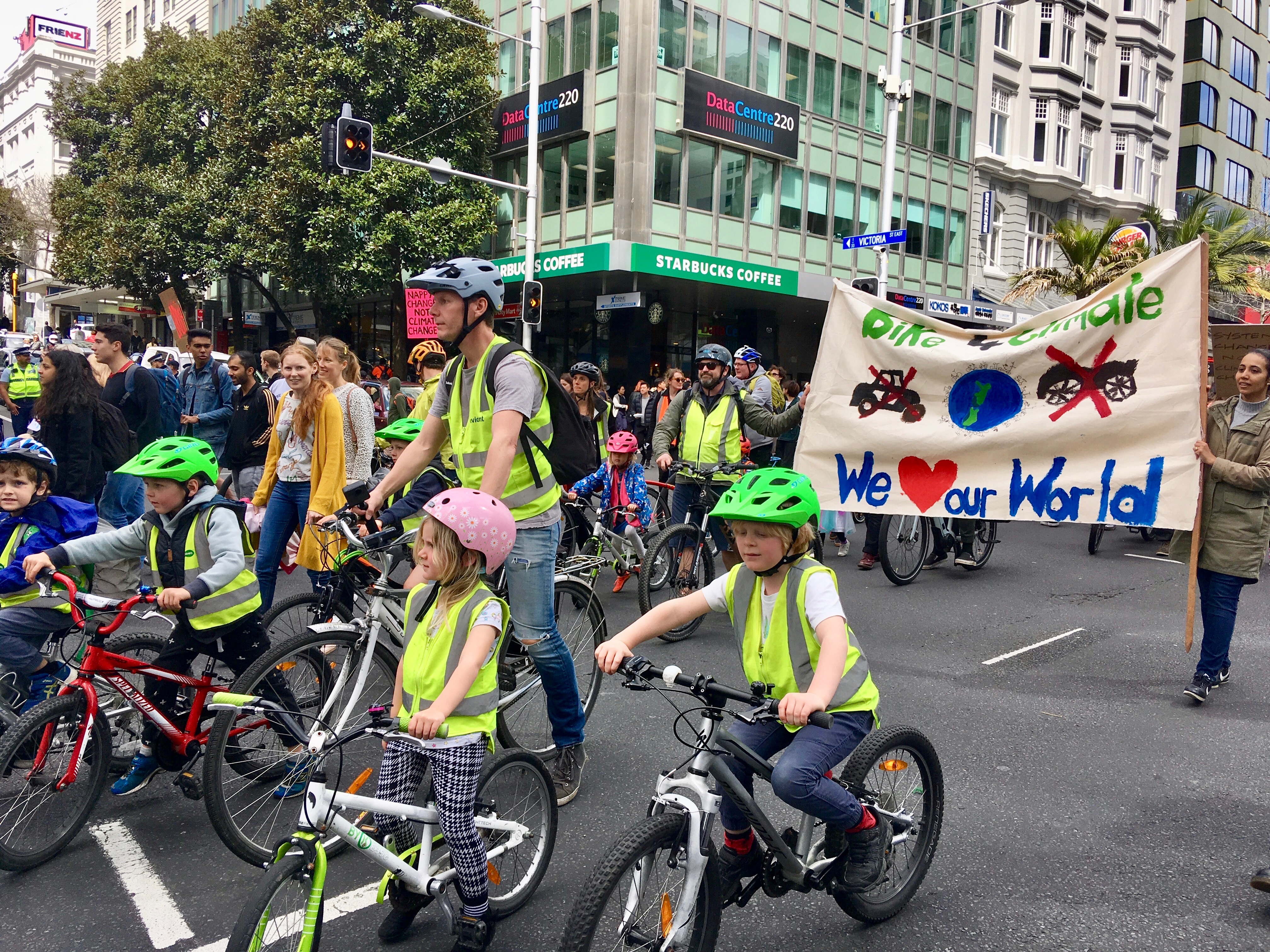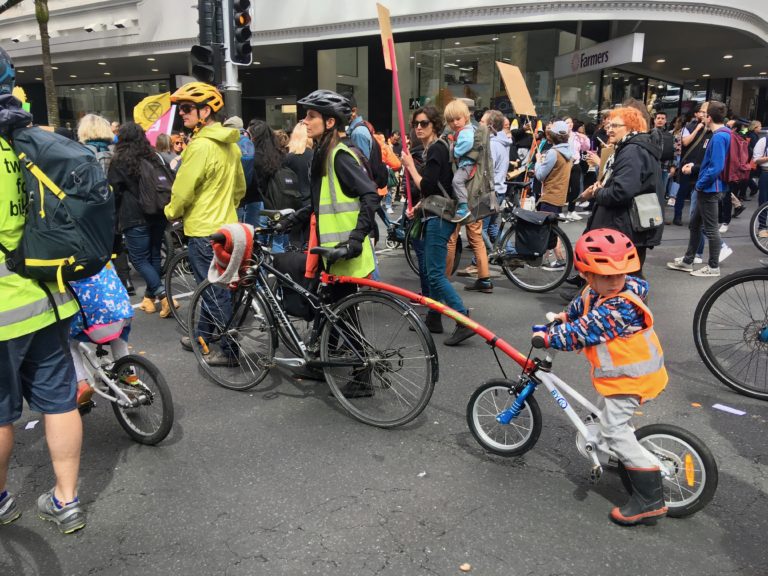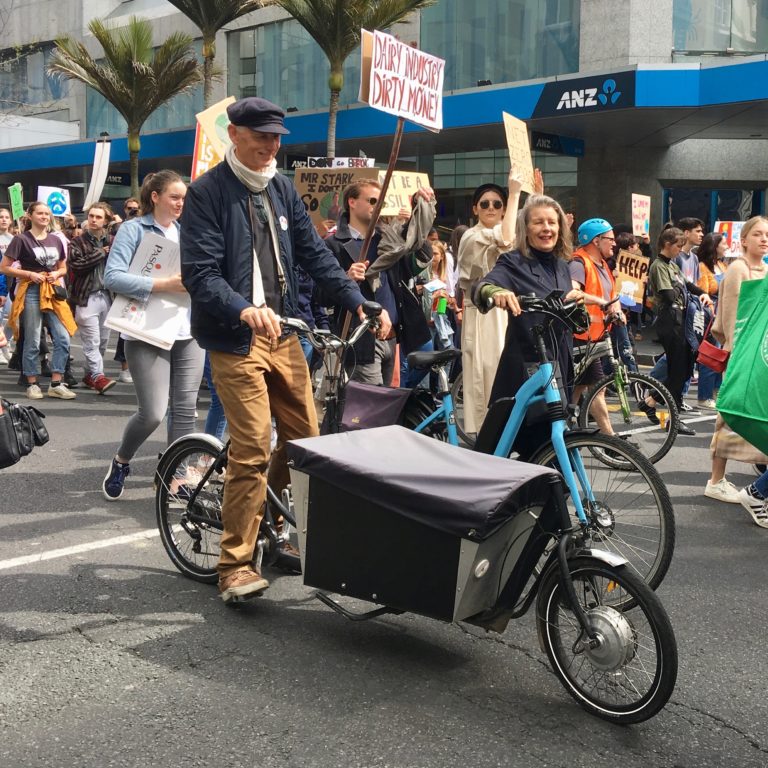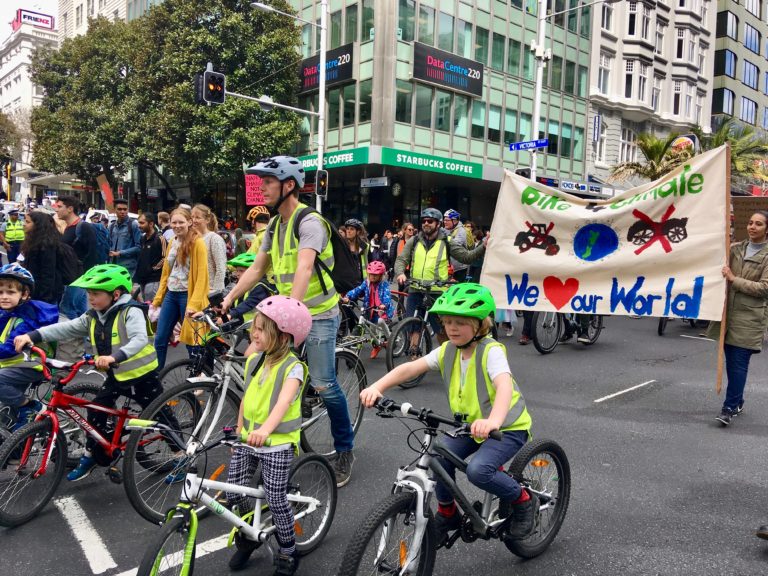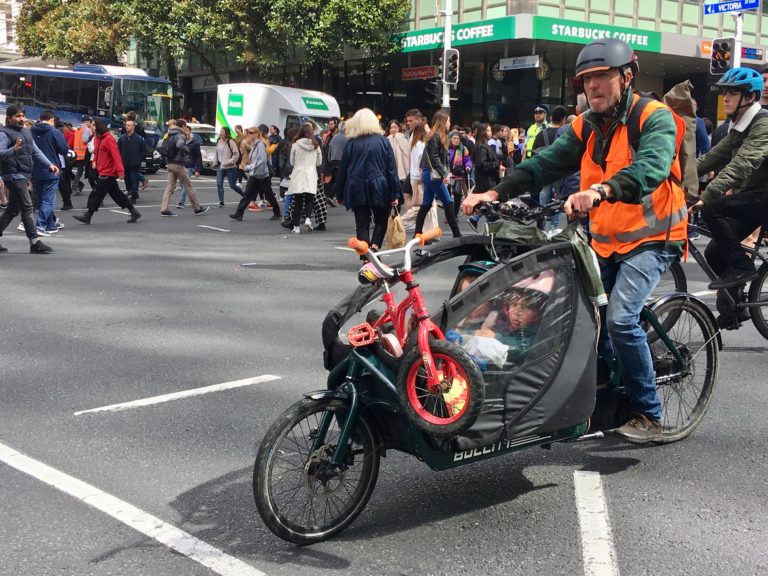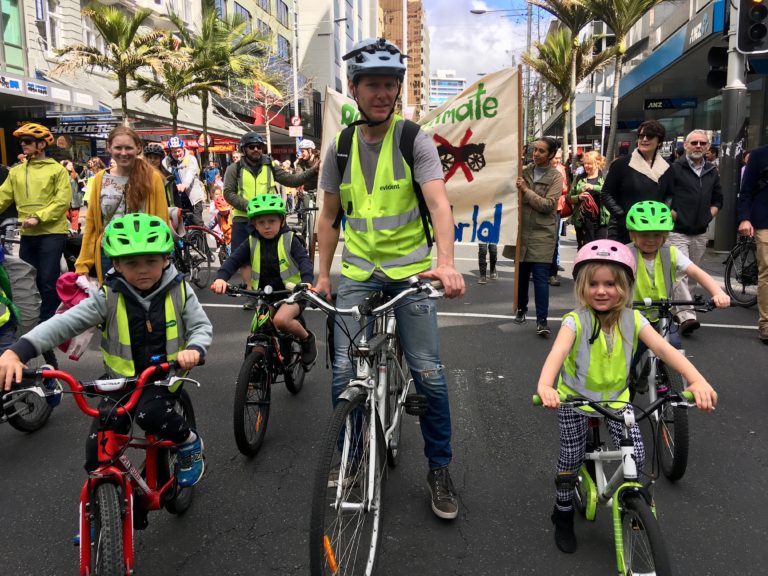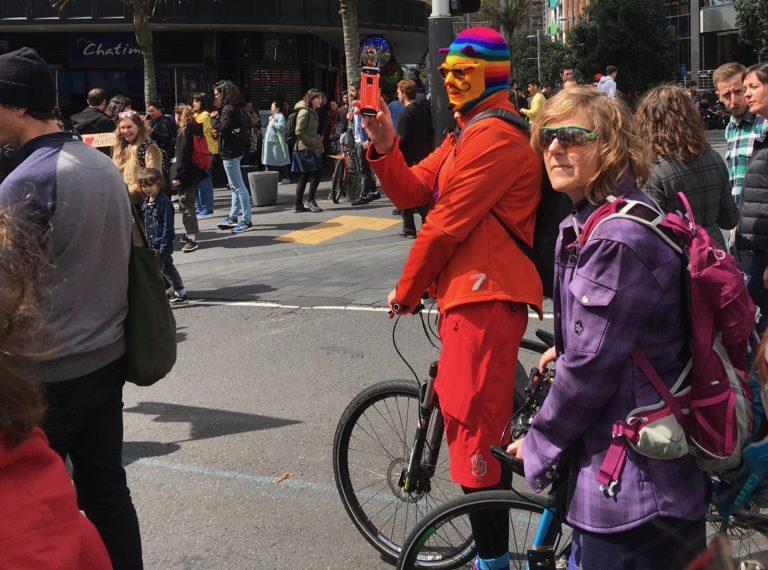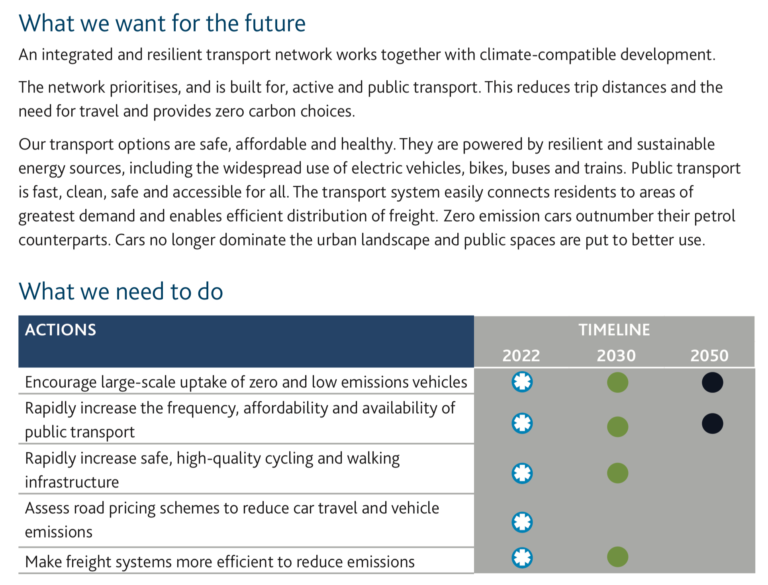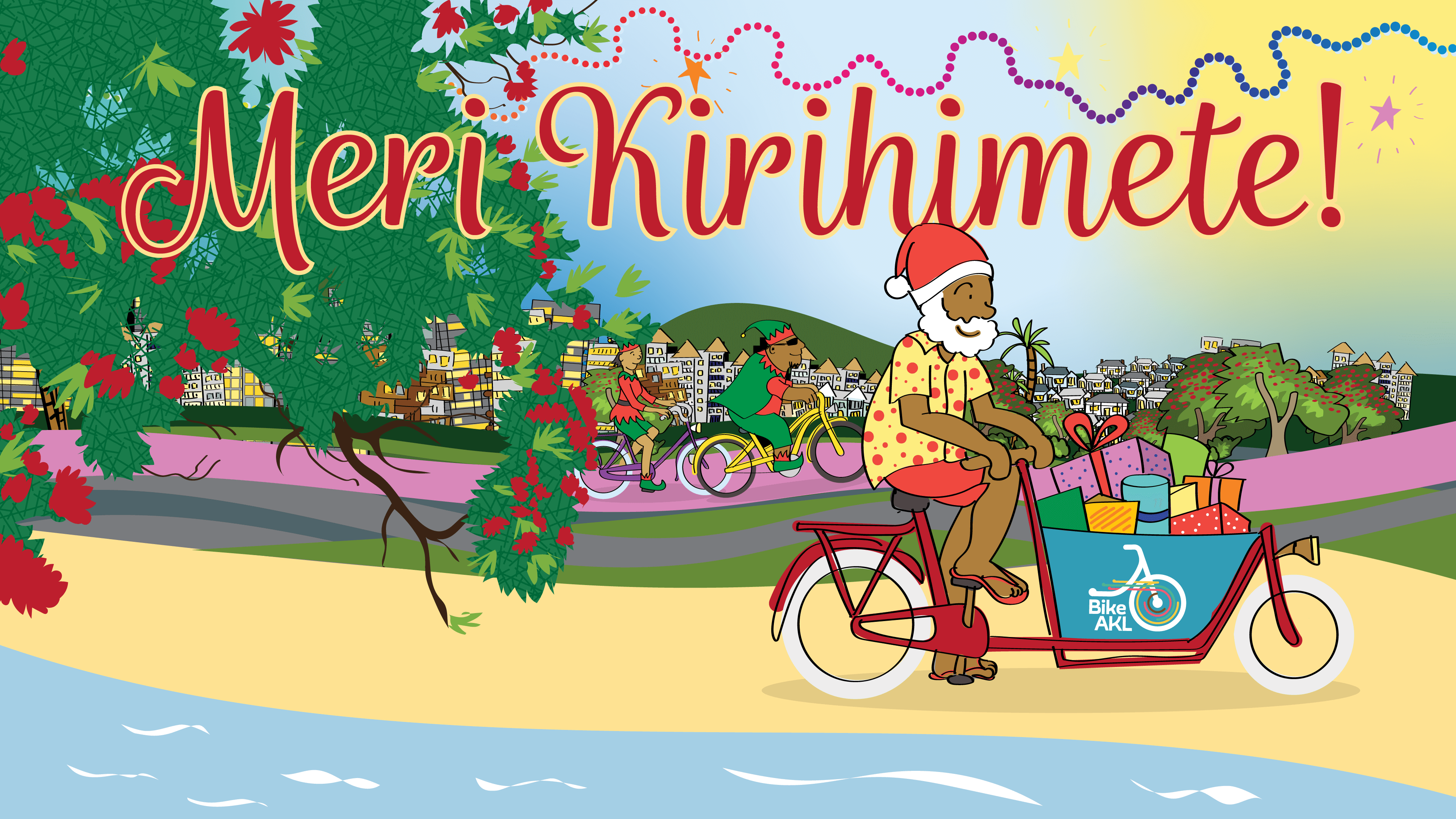Bikes are climate action: sustainable, fuel-free, all-ages transport, that leaves you and the world around you better off. So it’s good to see bikes are a key element in Auckland Council’s Climate Action Framework. (NOTE: Feedback closes 8pm Monday 30 September – use our speedy feedback guide here to have your say quickly and easily!).
We also loved seeing all the kinds of bikes, and the variety of people on them, at the huge Climate Strike on Friday. It’s fantastic to see people walking the talk, including the wee Pt Chev School Bike Train kids who pedalled 7km each way to join the march. We know tens of thousands of Aucklanders would love to do the same, if it felt safer to bike where they live and where they want to go.
So it’s encouraging to see bikes proudly in the picture for the Climate Action Framework: on the cover, on the intro page, and in the graphics throughout, as well as mentioned throughout the document. And we know some of the city’s top climate champions, both on Council and inside Council’s offices, bike to work almost every day. Our leaders are already walking the talk. (Oh hey – have you voted? Check out our election info page here to find out who’s ready to be a hands-on visionary for cycling in the next three years!)
But for meaningful action on climate change, we need to make sure words can be transformed into action across the city. So let’s look at how the Climate Action Framework – and the plan that will follow – could address obstacles to progress, get everyone on the same page, and empower many more Aucklanders to go by bike whenever and wherever they like.
The Key Moves for Climate Action
The Climate Action Framework proposes eleven ‘key moves’ to cut Auckland’s emissions and the impacts of climate change:
1. Lay the foundation
2. Enhance, restore and connect our natural environments
3. Make development and infrastructure climate-compatible
4. Transform existing buildings and places
5. Deliver clean, safe and equitable transport options
6. Move to a zero carbon, climate-resilient economy
7. Help Aucklanders become more resilient and reduce their carbon footprint
8. Te puawaitanga o te tangata
9. Youth and intergenerational equity
10. Shift to decentralised renewable energy
11. Grow a low-carbon, resilient food system
For our purposes, Key Move 5 is where the action is, and it proposes two approaches in particular:
- To “rapidly increase safe, high-quality walking and cycling infrastructure” as part of “an integrated and resilient transport network.”
- To see this “rolled out at scale and pace“, particularly from 2023-2030.
This is great, because the time for sloooooow incrementalism is long behind us. An integrated, resilient transport network, delivered rapidly, ‘at scale and at pace’, by 2030? Bring it on! Totally do-able, right?
And the benefits are clear – although we’d say high-quality walking and cycling infrastructure ticks ALL the benefit boxes below: 
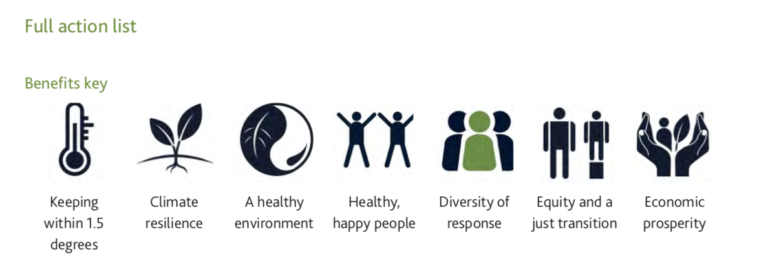
Not so fast…
Who’s in charge of delivering the cycling infrastructure “at scale and at pace”? Will they have enough resources to do it? And are they all on the same page?
The players: Auckland Transport delivers all infrastructure on city roads and streets, and Council’s parks department oversees paths that run through Council-owned green spaces. Each Local Board has a Transport Capital Fund to spend on local transport projects, a Community Safety Fund for local safety projects, and (most have) a Greenways plan for strategic local routes, including through parks.
Then there are the motorway corridor routes (e.g. the Northwestern Cycleway, the northern and southern corridor cycleways, and of course Skypath 2.0!), which are delivered by the NZ Transport Agency. Any coordinated plan needs all parties to be working together – and where possible, to be working with Watercare, Vector, and other parties to maximise opportunities and minimise cost by digging once and doing it right.
The resources: The NZ Transport Agency is adding cycleways to motorway projects down south (between Takanini and Papakura) and up north (as part of the NCI project), as well as out west (from Lincoln Road to Westgate).
Meanwhile, AT is currently finishing up the overrun from the 2015-2018 Urban Cycleway Programme, which will tie up funding and focus for the next two years. Beyond that, things are a bit fuzzy – officially, AT is still working to the Ten-Year Cycling Strategy, according to which, by 2023 the areas for “early construction” will just be getting under way and at current pace wouldn’t be finished before 2030. This in turn means the areas for “late construction” won’t get a lick of the planning spoon before 2028, at best. (As for the rest of the city, who knows?)
AT is concurrently working on the Integrated Corridor Programme, aka “Connected Communities”, which aims to prioritise public transport and walking and biking along key arterial routes. The timeline for that programme stretches into the next decade, and there’s as yet no guarantee that it will deliver quality bike routes on every corridor on the list.
The plan: With everyone working to their own plan, the wider strategy remains patchy, and vast amounts of the city simply won’t get a look in. You can see examples of this all over – inconsistent standards, missing links, gaps on the map. Bike Auckland is doing its best to get everyone on the same page, and the new Transport Design Manual should help, in theory, with ensuring consistency of approach.
There’s also a gap when it comes to targets. Other cities are busy setting and meeting ambitious goals. Some – like Vancouver –have been achieved so fast they’ve now had to set newer, even more ambitious targets. AT’s current goal is 10km/year.
What this all means for Auckland is that delivering a meaningful network “at scale and at pace” will be near impossible – even without tackling the business-case cliff-face and wading through the swamp of consultation.
So here’s the challenge!
How can our Council deliver on the transport part of its Climate Action Plan, inside the current budget, planning, and delivery capacity?
Start by convening all delivery partners to (re)commit to a plan. (To our mind, this will be easier once AT has filled the still vacant strategic role of Head of Healthy Streets and Active Modes). With everyone working to the same plan, everyone will be faster to spot opportunities and efficiencies in the budget.
Next step, work out how to deliver it: where will the extra capacity and investment come from?
A zero-sum approach would say you’d have to carve it out of either public transport or roading projects. Transport executives tend to assume worried expressions when you raise this possibility, because the big budgets are all sewn up by big projects, and taking even a little bit away might cause ‘uncertainty’ in the sector.
To our ears, that’s a bit like saying, ‘Well, we could give you more mouse food, but we’ll have to cut the elephant rations, and you wouldn’t want the elephants fainting on you, would you?”
The point is that the mice and the elephants occupy the same habitat. And the mice, while nimble survivors, and growing in numbers by nibbling on whatever falls out of the elephants’ manger, are getting trampled. (Hey, it’s not a perfect metaphor, but let’s roll with it.) And as any elephant who reads the classics knows, mice are your friends.
We say it’s time to flip the question, and the budget. Because those of us already walking and biking are doing our part.
We’re making the best of a dangerous and incomplete network, suffering decades of neglect, and – despite recent gains – a budget that barely scratches the surface.
We’re also most at risk from the heavier transport modes, specifically cars, trucks, and buses. So how about deploying the elephantine budget to even the odds in the ecosystem we all share?
After all, the urgent need for more raised crossings, protected cycleways, and safer speeds isn’t the fault or responsibility of people walking and biking. So why must those improvements come out of the relatively small (and long overdue) budget set aside for walking, cycling, and safety? A protected bike lane, for example, isn’t cycling infrastructure so much as driving infrastructure, designed to ensure four-wheeled vehicles stay in their lane.
Go big or go home!
To translate into action, Key Move #5 must be accompanied by directives and the tools to unlock delivery:
Create an integrated plan for delivering a cycling network “at scale and at pace”, to be embraced and acted on by all transport agencies and delivery partners. Let’s not miss a single opportunity to do the right thing.
Refocus the budget. It’s time to scour big budgets for small improvements, across the board. We need to seek and create active transport and micromobility opportunities within every transport project, to address decades of inequitable investment and the urgent need for change.
Dig once. In particular, all routine road renewals, especially of any streets on the Auckland Cycle Network, should deliver safety upgrades for walking and biking. It’s the fiscally prudent thing to do, as well as the climate-responsible one. Likewise, any project that involves digging up the street should be looked at to see how it can put the street back in a more climate-responsible fashion. More trees, better bike lanes, raised crossings? Do it.
Build active transport into and around public transport. For example: once the CRL opens, once the Puhinui interchange opens, once the NW busway and/or light rail is built, public transport use will rise even further. How are all the new travellers going to get to the stations? And how much healthier, cleaner, and more space-efficient will our city be if more of us come by bike instead of car? Large scale public transport investment must include safe bike-and-scoot routes and copious bike parking.
Maximise public transport capacity by continuing to build the cycling network to maximise the ‘last mile’ demographic, for the central city and for key employment, education and transport hubs. It’s not rocket science: if 50 people who live closest to the city (or to a major transport node) can jump on an e-bike instead of a bus, that’s one less bus AT has to fund and squeeze onto our morning roads.
Democratise our transport options by creating low-traffic neighbourhoods. Those who are least likely to drive are most likely to be taking local trips, many of which will be almost too short for public transport, in particular schoolchildren and the elderly. (Reportedly, 50% of Auckland’s school runs by car are purely about the pick-up or drop-off, rather than part of a longer journey). Creating low-traffic (and safe speed) neighbourhoods will empower more of our youngest and oldest citizens to walk or bike, and makes carbon-free local travel more thinkable for everyone. Auckland is a city of villages: by 2030, many of those villages will need to be “mini-Hollands” if we are to meet our climate responsibilities.
Future-proof our transport system by making space for scooters and other micromobility. Forget the flying cars: look to the two- and three-wheeled equivalents at ground level.
Set clear and tangible targets that are both ambitious and achievable, both interim and long term. For example:
- Kilometres/ year of separated, protected cycleways on arterial roads. This can include tactical / pop-up protection as a way of freeing up the currently suppressed demand for safe bike travel through Auckland’s neighbourhoods. We suggest lifting the current target from 10km/ year of protected bike lanes to 50 km/year of “climate-protecting bike lanes”, using tactical approaches and “pop-up protection” on existing lanes.
- % of trips made by bicycle. See for example the University of Otago’s Active Living Laboratory report ‘Turning the Tide‘ (2019), which recommends doubling cycling trips each decade, so that 15% of trips are by bicycle by 2050.
- % of trips to the city centre made by public transport and active transport. Look to the City of Vancouver as an example for Auckland’s Isthmus: they exceeded their original target of 50% active and public transport into the city by 2020 five years early, and have set a new goal of 2/3 by 2040.
- % of school trips made by walking, biking and scooting: these numbers have been in free-fall for years. Auckland Transport’s Safe School Routes project aims to turn them around, starting with a handful of pilot projects. Why wait?


